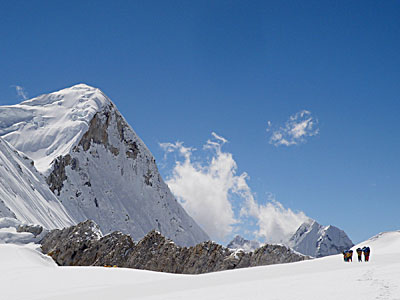 |
More than 9,200 trekkers descended on Khumbu in October?the largest number in that month since the Sagarmatha National Park was established 20 years ago and counting began. The steep trail to Namche Bajar was congested with hikers, yaks and porters.
"I have never, ever seen the Everest region so busy," said British trek leader Mike Truman. Some are calling for a ceiling on the number of people on the Everest trail every season.
The huge surge in the number of trekkers, and the extension of roads into the heart of the popular Annapurna trekking area, have led to growing calls for new hiking regions to be opened up to relieve the pressure on the most popular routes.
One proposal, backed by the Dutch group SNV and ICIMOD in Kathmandu is to create a Great Himalayan Trail along the entire length of Nepal, from near Kangchenjunga in the east to Api-Saipal in the far west, which could benefit 1.8 million people living in the mountains.
Australian tourism professional Robin Boustead has just tried out the first stretch, starting out from Suketar airfield in Taplejung and crossing nine high passes to get to Thame in Khumbu. During the entire trek that lasted more than a month, they saw just five other trekkers.
Boustead and trekking partner Bob Rosenbaum set out at the beginning of September. The first few weeks were marred by relentless rain and continual battles with leeches.
"Bob and I would spend the evenings picking leeches from each other," Boustead said. "The villagers were unconditionally welcoming and so open-hearted, it was humbling."
With their eight Nepali support crew, they fought their way through dense bamboo forests, raging rivers and across snowy passes with only a rather inaccurate map. "If someone gathered enough information on that area, it would be a great trek for everyone," Boustead said. "It may not be as comfortable as the Everest region but it is certainly an adventure."
While the tourist influx has brought welcome economic benefits to some, these remain very localised.
"The people in the areas outside the major trekking regions are still very poor, and the tourist business-if done in a sustainable manner-would certainly improve their lives," said Sam Voolstra, a tourism adviser for SNV.
Boustead, who lost 14kg on the walk, intends to return in the spring to continue along the next section of the 1,500km trail.
 PICTURES BY ROBIN BOUSTEAD Honku Basin from West Col with Ama Dablam at centre. |
 Lumbha Samba Pass looking east |
 Makalu from Sherpani Col |
 Chomolungma as seen from Renjo La |
 West Barun Glacier from Sherpani Col |
 Lumbha Samba first pass view of Jannu |
 Honku Basin from Amphu Labsta |
 west col from basin |
The goddess of the east
If you have a wish, go to Pathibhara
SAGUN S LAWOTI in TAPLEJUNG
 SAGUN LAWOTI Jannu Himal from Pathibhara |
"I was on my way to Siliguri to board a train," said Karki, sipping a cup of warm Tibetan tea at Suketar, Taplejung's airfield. "Friends casually mentioned Pathibhara Devi during the stopover in Birtamod. I don't know what made me do it, but I rescheduled my reservation and was off to Taplejung first thing in the morning."
To knowing nods, local man Suresh Limbu suggested that perhaps the goddess was calling Karki from his urban home.
"Now, if you have any wish, you can lay it before Pathibhara," Limbu added, explaining the strong faith shared by local people that the goddess fulfills people's wishes.
For Karki, the trip had come out of the blue. But there are large numbers of the devout who take a vow to come back again and again when their wishes are realised.
Dilli Acharya, one of the two temple priests, has little doubt that the shrine, nestled on a 3,7800m mountain top is bestowed with celestial powers. He claims the Pathibhara temple lies on a site where Parbati prayed for Lord Shiva. The sunset views of Kangchenjunga and Jannu Himal (see picture) from the temple is one of ethereal beauty.
"Since Parvati's prayers were answered, the same is reflected in the case of the devotees," Acharya says.
Indeed there are many who return frequently to pay their respects to the goddess. Some come to show off their newborn baby, others to express gratitude for their recruitment into the Gurkha regiment or to give thanks for overcoming a physical ailment.
"The reasons could be anything under the sun," says Surya Bhattarai, a devotee and member of the Pathibhara Devi Temple Conservation and Promotion Committee. "But pilgrims do come for prayers answered."
Bhattarai, a government employee, backed up his assertion citing several experiences of his own: "If not for the divine powers, why would the devotees continue coming?"
However, the name Pathibhara has nothing to do with the sanctity of the holy abode. The name came about simply because the temple sits atop a mountain resembling a pathi or measuring vessel. Local Limbus know the site as Bung: Muktu meaning 'powers' and 'tree'.
Little is known of the real origins of this long-venerated shrine, but according to local folklore, shepherds camping nearby were astonished when a flock of lambs disappeared into thin air. Their subsequent search proved fruitless. They later dreamt that they should make an animal sacrifice and after they had done so, the lambs reappeared.
"Since the people had literally lost all knowledge of the sacred site, this was the goddess's way of reacquainting the people with it," said Acharya, who lives at the site even throughout the harsh winter cold. "That act was her calling."
Taplejung is accessible by road via Ilam, or by direct flights to Suketar from Kathmandu or Biratnagar. From there Pathibhara is a three day roundtrip with easy walking.


